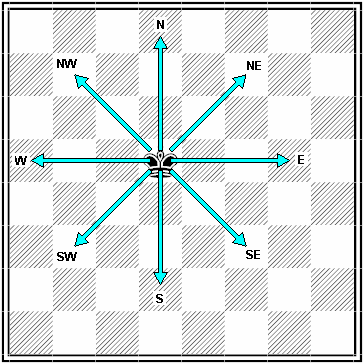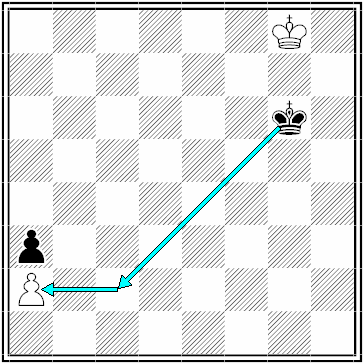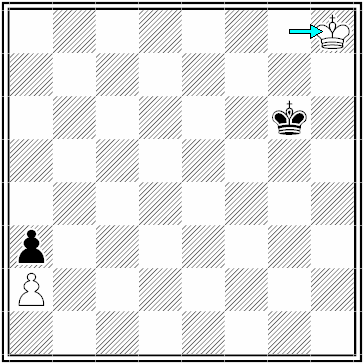Dance of the Kings
To get a better picture of the interference between the kings in the endgame, it is useful to have a few expedients for better communication.
The first is the windrose.
diagram 1.

A king can walk in only 8 directions. From now on I call these directions as their name in the windrose.
Most activity in endings take place with the kings circleing around each other at one square distance. It is useful to have a convenient naming system for all 12 different rotation positions.
diagram 2

To that end we think of it as a clock with the black king (the opponent) in the middle.
The white king is at the end of the short hand.
Horizontal opposition is 3 o'clock or 9 o'clock.
Vertical oppositon is 6 or 12 o'clock and so on.
The movements of the kings can be described with vectors (length = # moves, direction = according the windrose) and rotation.
With these tools we can easy describe new rules.
diagram 3.

begin position
(12 o'clock)
end position
(12 o'clock)
Black to move.
Begin position = Kg8, Kg6 (= position 12 o'clock)
When the black king walks south west and the white king follows at 1 square distance, there can be no rotation. When the black king arrives at b1, the white king will still be in the 12 o'clock position.
Rule #1: when two kings walk in the same direction at close distance, they can't encircle each other.
And derived from rule #1:
Rule #2: When you want to encircle the enemy king, you can only do so at the expense of a tempo.
diagram 4.

Begin position
12 o'clock
End position
1 o'clock
White to move.
Blue = move 1
Red = move 2
Green = move 3 - 5
White uses a tempo to rotate from 12 o'clock to 11 o'clock.
Black starts to walk in SE-direction.
White follows at 1 o'clock, which will be the endposition too.
Let's have a look at a real position.
diagram 5.

White to move and draw.
It is clear white can't keep his pawn on the board.
How many extra tempo's has white?
The first spare tempo is the start tempo.
When both kings walk in the same direction, there can be no rotation.
The last 2 moves of black are in western direction, which provides white with another spare 2 tempo's. Don't bother to much about this, a little further this will be shown in a few diagrams.
Thanks to Takchess we now all know that you have to imagine the final position first.
See diagram 6.
diagram 6.

Begin position
12 o'clock
Final positon.
Kings 90 degrees rotated
3 o'clock
When the white king reaches the c2 right after the black king has eaten the white pawn, white can hold the draw.
In the start position the white king is at 12 o'clock and in the final position at 3 o'clock.
So white has to rotate with the black king in the center 3 times (3 x 30 degrees = 90 degrees).
At the expense of 3 spare tempi.
Hence the start move of white must be 1. Kh8!!
I'll give you all the important moves in the next diagrams.
diagram 7

1. Kh8!!
1st rotation from 12 o'clock to 1 o'clock at the expense of the start tempo.
See diagram 7
diagram 8.

2. ... Kf5
3. Kg7 Ke4
4. Kf6 Kd3
5. Ke5 Kc2
6. Kd4
Translation over 4 moves in SW-direction.
No rotation. See diagram 8
diagram 9.

6. ... Kb2
7. Kd3
The translation of the black king to the west (Kc2-Kb2-Kxa2) will cost him 2 additional tempo's
The white king rotates around the black king from 1 o'clock to 2 o'clock at the cost of the first additional tempo. See diagram 9.
diagram 10.

7. ... Kxa2
8. Kc2 =
The white king rotates further from 2 o'clock to 3 o'clock.
Draw!
See diagram 10.
Can you see for yourself now why 1. Kf8? loses the game?
The first is the windrose.
diagram 1.

A king can walk in only 8 directions. From now on I call these directions as their name in the windrose.
Most activity in endings take place with the kings circleing around each other at one square distance. It is useful to have a convenient naming system for all 12 different rotation positions.
diagram 2

To that end we think of it as a clock with the black king (the opponent) in the middle.
The white king is at the end of the short hand.
Horizontal opposition is 3 o'clock or 9 o'clock.
Vertical oppositon is 6 or 12 o'clock and so on.
The movements of the kings can be described with vectors (length = # moves, direction = according the windrose) and rotation.
With these tools we can easy describe new rules.
diagram 3.

begin position
(12 o'clock)
end position
(12 o'clock)
Black to move.
Begin position = Kg8, Kg6 (= position 12 o'clock)
When the black king walks south west and the white king follows at 1 square distance, there can be no rotation. When the black king arrives at b1, the white king will still be in the 12 o'clock position.
Rule #1: when two kings walk in the same direction at close distance, they can't encircle each other.
And derived from rule #1:
Rule #2: When you want to encircle the enemy king, you can only do so at the expense of a tempo.
diagram 4.

Begin position
12 o'clock
End position
1 o'clock
White to move.
Blue = move 1
Red = move 2
Green = move 3 - 5
White uses a tempo to rotate from 12 o'clock to 11 o'clock.
Black starts to walk in SE-direction.
White follows at 1 o'clock, which will be the endposition too.
Let's have a look at a real position.
diagram 5.

White to move and draw.
It is clear white can't keep his pawn on the board.
How many extra tempo's has white?
The first spare tempo is the start tempo.
When both kings walk in the same direction, there can be no rotation.
The last 2 moves of black are in western direction, which provides white with another spare 2 tempo's. Don't bother to much about this, a little further this will be shown in a few diagrams.
Thanks to Takchess we now all know that you have to imagine the final position first.
See diagram 6.
diagram 6.

Begin position
12 o'clock
Final positon.
Kings 90 degrees rotated
3 o'clock
When the white king reaches the c2 right after the black king has eaten the white pawn, white can hold the draw.
In the start position the white king is at 12 o'clock and in the final position at 3 o'clock.
So white has to rotate with the black king in the center 3 times (3 x 30 degrees = 90 degrees).
At the expense of 3 spare tempi.
Hence the start move of white must be 1. Kh8!!
I'll give you all the important moves in the next diagrams.
diagram 7

1. Kh8!!
1st rotation from 12 o'clock to 1 o'clock at the expense of the start tempo.
See diagram 7
diagram 8.

2. ... Kf5
3. Kg7 Ke4
4. Kf6 Kd3
5. Ke5 Kc2
6. Kd4
Translation over 4 moves in SW-direction.
No rotation. See diagram 8
diagram 9.

6. ... Kb2
7. Kd3
The translation of the black king to the west (Kc2-Kb2-Kxa2) will cost him 2 additional tempo's
The white king rotates around the black king from 1 o'clock to 2 o'clock at the cost of the first additional tempo. See diagram 9.
diagram 10.

7. ... Kxa2
8. Kc2 =
The white king rotates further from 2 o'clock to 3 o'clock.
Draw!
See diagram 10.
Can you see for yourself now why 1. Kf8? loses the game?
Thanks for the cheering. Knowing that someone is actually reading my writings is stimulating.
ReplyDeleteYou are a true explorer of the mathematics of the chessboard.
ReplyDeleteI'm not convinced that this exploration is the best way to for you become a better endgame player, but maybe that's not your point.
Perhaps it is, like Star Trek, to boldly go where no man has gone before.
I say that you are to endgames what Hans Kmoch was to pawn structures- like Kmoch, you are inventing a new vocabulary. Who cares if it doesn't achieve common usage- it helps to illustrate the depth and majesty of the game.
Funky,
ReplyDeleteof course you are right. This is probably the LEAST effective way to learn endgames. But then again I have to ask myself, is there another way for me to learn endgames? The answer is no, because otherwise I have to violate my nature.
So I'm convicted to the most slow grinding, merciless master of all: Logic.
Logic is destructive in it's nature, it isn't creative. You can only proof that something is NOT true.
And so I have to try everything and proof that it is NOT the way to go before I can set the next step.
It is gruesome SLOW, but very CERTAIN.
You only can be sure you will find the true solution IN THE END.
If you live long enough.
It is NOT logical to start with piece endings when you don't know how to play the underlying pawn ending.
It is NOT logical to start with more complicated pawn endgames when you don't even understand the most simple ones with ONLY TWO pawns.
Who of you would have played 1.Kh8!! at first sight at the problem in my post?
The reward is great however!
I stumble from astonishment to astonisment.
Who would have thought the following would be true:
(citation from "Tragicomedies in pawn endgames - Mark Dvoretsky)
[start citation]
“Pawn endgames are rare birds in practice. Players avoid them, because they
do not like them, because they do not understand them. It’s certainly no secret
that pawn endings are ‘terra incognita’ - even for many masters, right up to the
level of grandmasters and world champions.” - N. Grigoriev
Herewith, I offer proof that these words, spoken by a famous expert on pawn endings, are true. - M. Dvoretsky.
[end citation]
How can two grandmasters write a book about pawn endings of 288 pages (SOPE)without even touching the items I come up with in my posts?
How is it possible that even grandmasters make failures in K+p vs K+p endings without causing commotion in the chess world?
Why is everybody dismissing pawn endings with "I calculate that OTB when the time is there"?
How is it possible I seem to be the first to write so?
Riddle after riddle.
Screaming for answers.
Who am I to resist?:)
BTW thanks for the tip of Hans Kmoch, I will have a look at it.
Very nice and comprehensive!
ReplyDeleteThis is great stuff. I love endgames and you love endgames- we each follow a separate path. Each approach has its own Truth.
ReplyDeleteYou seek the Truth of endgames from a reductionist, Cartesian approach.
I seek to immerse myself into the bath of classical endgame genius and hopefully emerge with a small amount of it clinging to my presently modest chess abilities.
I salute the Quest.
Wow, impressive conclusions. It's quite a dance the Kings have going on there.
ReplyDeletehey tempo. just thought i would let you know that the idea you (and i think takchess) had of invisioning the final/desired outcome helped me out last night. i was able to salvage a draw out of a lost game. thanks!
ReplyDeleteYou know, you *could* actually publish your own book from this. -
ReplyDeleteThe secrets of pawn endings.
And judging from the pictures you posts here, i think it would sell.
They're really very good you know.
I love all the symmetry/rotation stuff with regards to trying to understand endgames. I am still trying to incorporate the imaginary unit i and complex rotational symmetry (multiplication by i) into this!!
ReplyDeleteAfter an hour with this example, I'm not entirely sure I get your analysis. White needs three extra tempi to rotate 90 degrees and meet his objectives, black need two extra tempi to make the turn(a little heidegger reference) and head west from c2 to a2 to meet his objective. But it is all okay for white because he has an extra tempo in hand - it's his move.
But in actuality, white doesn't need the extra tempo. If it's black's move, white still draws. He can rotate regardless. There is something more to this example. I'll keep thinking about this very simple example. Regards, Brian.